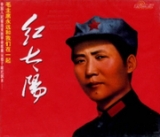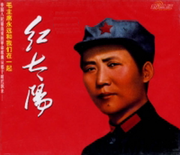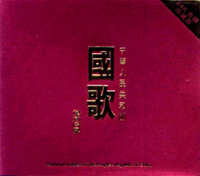
Guoyue
Encyclopedia
Guoyue is a modernized form of Chinese
traditional music written or adapted for some form of grand presentation, usually through a large orchestra of Chinese instruments. It was created in mainland China beginning in the early 20th century and is frequently broadcast on radio and television in the People's Republic of China
. It is also the primary form of Chinese music taught in conservatories in China, as well as in Taiwan
and Singapore
.
The light end is the typical "Patriotic Music". It is usually performed by some collection of instrument or orchestra. It is equivalent to national anthems performed in other countries, perhaps taken more seriously by the Chinese government.
The extreme end is termed "Revolutionary Music". There is often a political or Maoist message.
However, this usage of the term are limited to English speaking areas; in China, Taiwan and Singapore, the term refers to traditional Chinese music
as a whole.
, guoyue is not necessarily seen as negative, as it can represent both a communist and socialist view. Outside of the mainland, especially in the more democratic and commercialized parts of Asia, guoyue is often seen as revolutionary and pro-communistic almost without question.

, the guoyue music genre came about to promote greater patriotism after the fall of the last dynasty
. Many groups in Shanghai associated themselves as "National Music Clubs" (國樂會) such as the Datong Music Club.http://books.google.com/books?id=GxCF5Q3BvYgC&pg=PA210&dq=%22guoyue%22+datong+club Identity and national pride became important during the Second Sino-Japanese War
and the Chinese Civil War
throughout the 1930s.
relocated to Taiwan, and the People's Republic of China
was established. The Communist Party
would promote revolutionary music while suppressing traditional music and Chinese popular music
.
The songs were presented differently from the usual national anthems, since the government made a genuine effort to upgrade the music for a political cause. An example is Lin Biao
in 1964 promoting that "all Chinese were urged to learn from the People's Liberation Army", who were taught 11 revolutionary songs. For the musicians of the era, they were expected to model their work after the army's musical organization The Communist movements and propaganda during the 1960s and 1970s was successful enough that people listened to revolutionary music as a main genre. The national anthem of March of the Volunteers
was suspended in favor of The East Is Red
during the cultural revolution
.
was formally elected to the "International Musicological Society". Chinese musical groups toured foreign countries, and foreign musical organizations performed in China. In the mid-1980s popular ballads, western folk
and classical music still drew the greatest audiences, but other kinds of music, including previously banned western jazz
and rock and roll
, were being performed with greater acceptance especially among the youth.
were updated into disco
-like arrangements released in Shanghai
by the China Record Company. The album titled "The Red Sun" (紅太陽) became an instant best seller. For nostalgia
, social, patriotic or entertainment purposes, there are many reasons why the genre have leaned so close to commercial music in the past. A lot has to do with the Communist censorship imposed in other genres, giving the people less choice.
in the 2000s by Taiwanese composer Jay Chou
and songwriter Vincent Fang
, who coined the term Zhongguo Feng (中國風; lit. Chinese Wind) to describe the style of the album The Eight Dimensions
which fuses modern rock and contemporary R&B together with traditional Chinese music.

Usually it combines traditional instruments with western ones. Like in The East is Red
, melodies of traditional instruments like erhu
and sheng
are combined with western ones such as Violin and trumpets.
. The lyrics did get censored by the government to some degree for being too extreme. But it demonstrates how far the lyrics can go.
China
Chinese civilization may refer to:* China for more general discussion of the country.* Chinese culture* Greater China, the transnational community of ethnic Chinese.* History of China* Sinosphere, the area historically affected by Chinese culture...
traditional music written or adapted for some form of grand presentation, usually through a large orchestra of Chinese instruments. It was created in mainland China beginning in the early 20th century and is frequently broadcast on radio and television in the People's Republic of China
People's Republic of China
China , officially the People's Republic of China , is the most populous country in the world, with over 1.3 billion citizens. Located in East Asia, the country covers approximately 9.6 million square kilometres...
. It is also the primary form of Chinese music taught in conservatories in China, as well as in Taiwan
Taiwan
Taiwan , also known, especially in the past, as Formosa , is the largest island of the same-named island group of East Asia in the western Pacific Ocean and located off the southeastern coast of mainland China. The island forms over 99% of the current territory of the Republic of China following...
and Singapore
Singapore
Singapore , officially the Republic of Singapore, is a Southeast Asian city-state off the southern tip of the Malay Peninsula, north of the equator. An island country made up of 63 islands, it is separated from Malaysia by the Straits of Johor to its north and from Indonesia's Riau Islands by the...
.
Characteristics
Guoyue is practically measured at the political and ideology level. There are basically two ends of the spectrum.The light end is the typical "Patriotic Music". It is usually performed by some collection of instrument or orchestra. It is equivalent to national anthems performed in other countries, perhaps taken more seriously by the Chinese government.
The extreme end is termed "Revolutionary Music". There is often a political or Maoist message.
However, this usage of the term are limited to English speaking areas; in China, Taiwan and Singapore, the term refers to traditional Chinese music
Yayue
Yayue , Wade-Giles ya-yüeh; ; ; ) was originally a form of Chinese classical music that was performed at imperial courts. The basic conventions of yayue were established in the Western Zhou. Together with law and rites, it formed the formal representation of aristocratic political power...
as a whole.
Perspective
Within mainland ChinaMainland China
Mainland China, the Chinese mainland or simply the mainland, is a geopolitical term that refers to the area under the jurisdiction of the People's Republic of China . According to the Taipei-based Mainland Affairs Council, the term excludes the PRC Special Administrative Regions of Hong Kong and...
, guoyue is not necessarily seen as negative, as it can represent both a communist and socialist view. Outside of the mainland, especially in the more democratic and commercialized parts of Asia, guoyue is often seen as revolutionary and pro-communistic almost without question.
History

Origin
In the 1920s, as part of the New Culture MovementNew Culture Movement
The New Culture Movement of the mid 1910s and 1920s sprang from the disillusionment with traditional Chinese culture following the failure of the Chinese Republic, founded in 1912 to address China’s problems. Scholars like Chen Duxiu, Cai Yuanpei, Li Dazhao, Lu Xun, Zhou Zuoren, and Hu Shi, had...
, the guoyue music genre came about to promote greater patriotism after the fall of the last dynasty
Qing Dynasty
The Qing Dynasty was the last dynasty of China, ruling from 1644 to 1912 with a brief, abortive restoration in 1917. It was preceded by the Ming Dynasty and followed by the Republic of China....
. Many groups in Shanghai associated themselves as "National Music Clubs" (國樂會) such as the Datong Music Club.http://books.google.com/books?id=GxCF5Q3BvYgC&pg=PA210&dq=%22guoyue%22+datong+club Identity and national pride became important during the Second Sino-Japanese War
Second Sino-Japanese War
The Second Sino-Japanese War was a military conflict fought primarily between the Republic of China and the Empire of Japan. From 1937 to 1941, China fought Japan with some economic help from Germany , the Soviet Union and the United States...
and the Chinese Civil War
Chinese Civil War
The Chinese Civil War was a civil war fought between the Kuomintang , the governing party of the Republic of China, and the Communist Party of China , for the control of China which eventually led to China's division into two Chinas, Republic of China and People's Republic of...
throughout the 1930s.
Birth of Revolutionary songs (1949–1970s)
In 1949 the KuomintangKuomintang
The Kuomintang of China , sometimes romanized as Guomindang via the Pinyin transcription system or GMD for short, and translated as the Chinese Nationalist Party is a founding and ruling political party of the Republic of China . Its guiding ideology is the Three Principles of the People, espoused...
relocated to Taiwan, and the People's Republic of China
People's Republic of China
China , officially the People's Republic of China , is the most populous country in the world, with over 1.3 billion citizens. Located in East Asia, the country covers approximately 9.6 million square kilometres...
was established. The Communist Party
Communist Party of China
The Communist Party of China , also known as the Chinese Communist Party , is the founding and ruling political party of the People's Republic of China...
would promote revolutionary music while suppressing traditional music and Chinese popular music
C-pop
C-pop is an abbreviation for Chinese popular music , a loosely defined musical genre by artists originating from mainland China, Hong Kong, and Taiwan. Others come from countries where the Chinese language is used by a large number of the population, such as Singapore and Malaysia...
.
The songs were presented differently from the usual national anthems, since the government made a genuine effort to upgrade the music for a political cause. An example is Lin Biao
Lin Biao
Lin Biao was a major Chinese Communist military leader who was pivotal in the communist victory in the Chinese Civil War, especially in Northeastern China...
in 1964 promoting that "all Chinese were urged to learn from the People's Liberation Army", who were taught 11 revolutionary songs. For the musicians of the era, they were expected to model their work after the army's musical organization The Communist movements and propaganda during the 1960s and 1970s was successful enough that people listened to revolutionary music as a main genre. The national anthem of March of the Volunteers
March of the Volunteers
March of the Volunteers is the national anthem of the People's Republic of China , written by the noted poet and playwright Tian Han with music composed by Nie Er. This composition is a musical march...
was suspended in favor of The East Is Red
The East Is Red
"The East Is Red" is a song that was the de facto anthem of the People's Republic of China during the Cultural Revolution in the 1960s. The lyrics of the song were attributed to Li Youyuan, a farmer from northern Shaanxi, and the melody was derived from a local folk song...
during the cultural revolution
Cultural Revolution
The Great Proletarian Cultural Revolution, commonly known as the Cultural Revolution , was a socio-political movement that took place in the People's Republic of China from 1966 through 1976...
.
1980s
In 1980 the Chinese Musicians' AssociationChinese Musicians' Association
The Chinese Musicians Association is China's largest and most important musical organization. It was established in July 1949 and currently has 8000 members....
was formally elected to the "International Musicological Society". Chinese musical groups toured foreign countries, and foreign musical organizations performed in China. In the mid-1980s popular ballads, western folk
Folk music
Folk music is an English term encompassing both traditional folk music and contemporary folk music. The term originated in the 19th century. Traditional folk music has been defined in several ways: as music transmitted by mouth, as music of the lower classes, and as music with unknown composers....
and classical music still drew the greatest audiences, but other kinds of music, including previously banned western jazz
Jazz
Jazz is a musical style that originated at the beginning of the 20th century in African American communities in the Southern United States. It was born out of a mix of African and European music traditions. From its early development until the present, jazz has incorporated music from 19th and 20th...
and rock and roll
Rock and roll
Rock and roll is a genre of popular music that originated and evolved in the United States during the late 1940s and early 1950s, primarily from a combination of African American blues, country, jazz, and gospel music...
, were being performed with greater acceptance especially among the youth.
Mao nostalgia period (1990s)
As recent as 1991, anthems to Mao ZedongMao Zedong
Mao Zedong, also transliterated as Mao Tse-tung , and commonly referred to as Chairman Mao , was a Chinese Communist revolutionary, guerrilla warfare strategist, Marxist political philosopher, and leader of the Chinese Revolution...
were updated into disco
Disco
Disco is a genre of dance music. Disco acts charted high during the mid-1970s, and the genre's popularity peaked during the late 1970s. It had its roots in clubs that catered to African American, gay, psychedelic, and other communities in New York City and Philadelphia during the late 1960s and...
-like arrangements released in Shanghai
Shanghai
Shanghai is the largest city by population in China and the largest city proper in the world. It is one of the four province-level municipalities in the People's Republic of China, with a total population of over 23 million as of 2010...
by the China Record Company. The album titled "The Red Sun" (紅太陽) became an instant best seller. For nostalgia
Nostalgia
The term nostalgia describes a yearning for the past, often in idealized form.The word is a learned formation of a Greek compound, consisting of , meaning "returning home", a Homeric word, and , meaning "pain, ache"...
, social, patriotic or entertainment purposes, there are many reasons why the genre have leaned so close to commercial music in the past. A lot has to do with the Communist censorship imposed in other genres, giving the people less choice.
2000s
Guoyue music made its comeback into mainstream popular musicPopular music
Popular music belongs to any of a number of musical genres "having wide appeal" and is typically distributed to large audiences through the music industry. It stands in contrast to both art music and traditional music, which are typically disseminated academically or orally to smaller, local...
in the 2000s by Taiwanese composer Jay Chou
Jay Chou
Jay Chou is a Taiwanese musician, singer-songwriter, music and film producer, actor and director who has won the World Music Award four times. In 1998 he was discovered in a talent contest where he displayed his piano and song-writing skills. Over the next two years, he was hired to compose for...
and songwriter Vincent Fang
Vincent Fang
Vincent Fang was born on 26 January 1969 in Hualien, Taiwan. He is a Taiwanese multi-Golden Melody Award nominated lyricist, best known for his collaboration with singer-songwriter Jay Chou...
, who coined the term Zhongguo Feng (中國風; lit. Chinese Wind) to describe the style of the album The Eight Dimensions
The Eight Dimensions (album)
The Eight Dimensions is Taiwanese Mandopop artist Jay Chou's third Mandarin studio album. It was released on 18 July 2002 by Alfa Music and distributed by Sony Music Taiwan....
which fuses modern rock and contemporary R&B together with traditional Chinese music.
Style

Patriotic Songs
Guoyue patriotic songs ensembles range from chamber groups to quite large orchestras which are led by a conductor. Orchestral guoyue compositions are often arranged in concerto-like form, for solo instrument and orchestra, and often incorporate some use of Western harmony.Usually it combines traditional instruments with western ones. Like in The East is Red
The East Is Red
"The East Is Red" is a song that was the de facto anthem of the People's Republic of China during the Cultural Revolution in the 1960s. The lyrics of the song were attributed to Li Youyuan, a farmer from northern Shaanxi, and the melody was derived from a local folk song...
, melodies of traditional instruments like erhu
Erhu
The erhu is a two-stringed bowed musical instrument, more specifically a spike fiddle, which may also be called a "southern fiddle", and sometimes known in the Western world as the "Chinese violin" or a "Chinese two-stringed fiddle". It is used as a solo instrument as well as in small ensembles...
and sheng
Sheng
Sheng can refer to:* Sheng * Beijing opera#Sheng, the main role in Beijing opera* Sheng , a slang dialect of the Swahili language* Province , an administrative division of China, called sheng in Mandarin...
are combined with western ones such as Violin and trumpets.
Revolutionary songs
Any given patriotic song can be performed for a revolutionary cause. Sometimes compositions are done to reflect a legacy. An example is compositions by Zhang Guangtian's (張廣天) in 1993 idolizing the Cultural RevolutionCultural Revolution
The Great Proletarian Cultural Revolution, commonly known as the Cultural Revolution , was a socio-political movement that took place in the People's Republic of China from 1966 through 1976...
. The lyrics did get censored by the government to some degree for being too extreme. But it demonstrates how far the lyrics can go.
| Sample translated lyrics by Zhang Guangtian |
|---|
I move forward with you, Mao Zedong... Mao Zedong, Mao Zedong, with you I charge a hail of bullets When love and battle have become the same today Give me, ah give me power, Mao Zedong |
See also
- Cultural RevolutionCultural RevolutionThe Great Proletarian Cultural Revolution, commonly known as the Cultural Revolution , was a socio-political movement that took place in the People's Republic of China from 1966 through 1976...
- Musical nationalism
- Historical Chinese anthemsHistorical Chinese anthemsHistorical Chinese anthems comprise a number of Chinese official and unofficial national anthems composed during the early 20th century. Today, there are only two remaining:- "Tune of Li Zhongtang" :Quasi-official...
- Nhạc dân tộc cải biên, the Vietnamese counterpart to guoyue

